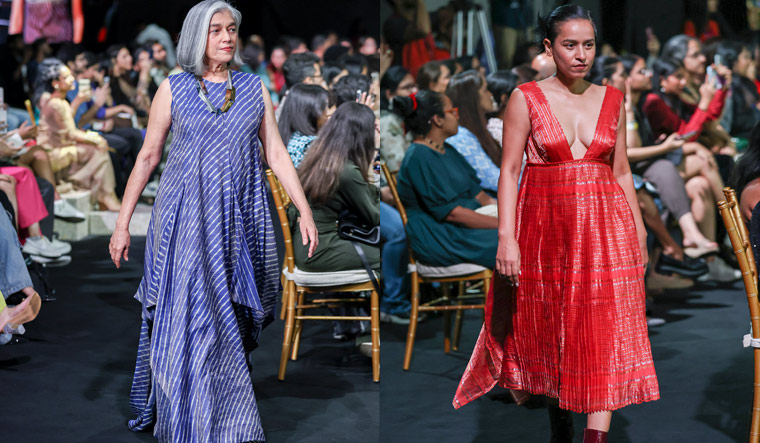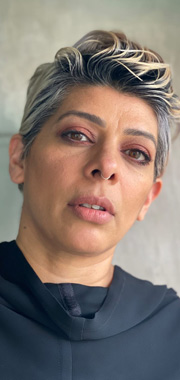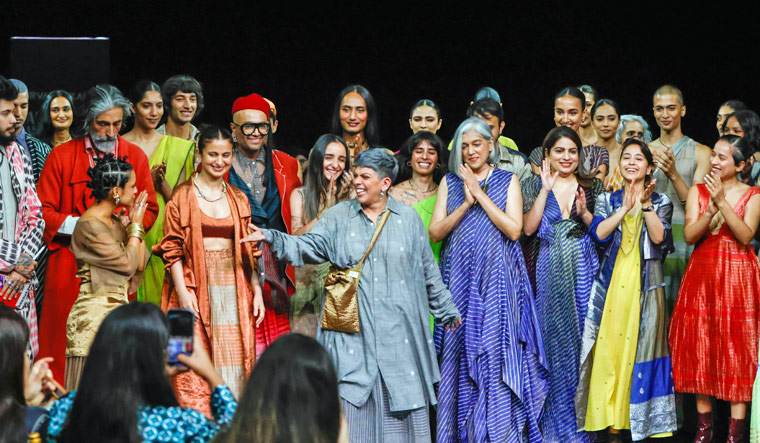Giving vintage textiles a modern, minimalist twist has been right up designer Urvashi Kaur’s alley. She made her debut at Lakme Fashion Week 15 years ago. Of course, she would return to the turf to celebrate her milestone.
And what a celebration it was. The show pulled together so many friends and muses of Kaur, 50, who walked for her eponymous label wearing her clothes. A live musician, Martin Dubois, played the harp instead of recorded music. The muses/ models were asked to do as they please, just be themselves, instead of walking to a pre-decided direction. There were actors Konkana Sen, Rasika Dugal, Tillotama Shome, Ratna Pathak Shah, Danish Husain, veteran stylist Gautam Kalra, chef Suvir Saran, artist Gurjeet Singh, and so many others.
The presentation was evocative, with Saran singing hauntingly, Husain making a case for Gaza on his palms, and the like. All of them were called ‘The Voices of Urvashi Kaur’.

“My many muses, whom you recently saw on the ramp at Lakme are stalwarts in their own right, their fundamental act of expression is what transforms them into visionaries and changemakers. My clothes are crafted for comfort, first and foremost, they are meant to be lived in and loved,” she says. “The muses were dressed in silhouettes from our offerings across our decade and a half,” she adds.

Kaur says the decision was natural. “It’s the non-models who invest in us, who support us, and who express themselves through our clothes. Ratna exemplifies grace, Suvir blurs the lines between the culinary and sartorial arts, Danish used this platform as a powerful call for change, artist Gurjeet’s soft sculptures speak of his norm-defying journey,” she explains.
Kaur has always been known for breezy designs—wearable, breathable clothes. The collection showcased androgynous separates like shirt dresses and tunics. Elements used included tissue silks, zari kota and zari tussars, brocades, and textural patchwork on co-ords and other fluid pieces; it was the embodiment of transitional style. Style that’s not limited to a season.
Sets designed from recycled packaging materials like Tetrapak and sounds of Dubois’ African harp set the mood. “Our atelier show – ‘Voices of Urvashi Kaur’ is a culmination of change and a harbinger of more to come,” Kaur says.
What has changed in 15 years? “The journey has been incredibly trying from when I first broke into the industry. I've come full circle to an extremely rewarding experience with the very same platform that I debuted at,” she adds.
When Kaur, who studied fashion in Paris, returned to India to start her label, she was met with skepticism in an industry where embellishments and bright colours were celebrated. Kaur says she was one of the first to contemporize Indian silhouettes in neutral palettes.
“My journey is filled with people and places, material memories and intangible ones. For as long as I can remember, I have always found inspiration and support in my tribe of fabulous creatives. I believe nothing represents our journey quite like a construct-defying, norm-shattering, experiential performance,” she smiles.
Delving into the ethos of upcycling, she says, “Through our ongoing ‘Renew’ project we are committed to reviving archival textiles in our contemporary aesthetic while moving forward towards a new chapter of our collective consciousness. The project is our way to break the wasteful cycles of overproduction and overconsumption. We once held pride in our heirlooms, cherished inheriting them from our elders, and supported legacies of artisanal wisdom through this traditional practice. Today we see a rise in consumers shifting away from embracing their heirlooms for a myriad of reasons. By collaborating with them to upcycle them in our own sartorial lexicon, allows our clients to reimagine what they may have considered to be damaged beyond repair or to simply transform a silhouette they may not feel comfortable with, into a more modern offering from us.”
The project, the designer explains, uses techniques like rafu, darning, and patchwork—like a local darzi might.
Kaur credits her army background for envisioning androgyny and gender fluidity in Indian fashion even before it became a ‘thing’. “Our beginnings were very humble and we led a nomadic lifestyle due to the constant need to travel. I was taught to be respectful and innovative with what we had by reusing and re-wearing what we had access to. Drowning in my brother’s oversized clothes I discovered my love for androgyny through hand-me-downs. Out of need, I began experimenting with anti-fit reinterpretations of his clothing to style as my own.”
She also credits her gender-neutral train of thought to being raised in an environment where no gender roles were forced on her and her brother. “I learned to sustain with very little and to live as lean as possible. My desire to create a visually soothing separation from my surroundings has shaped my signature design aesthetic,” Kaur says.
“Stemming from my graduate studies in History, I have a deeper interest in how clothing is connected to humankind at both a personal level of expression and at an anthropological level to offer fundamental shelter by clothing the body. More than an act of self-expression, it is a reflection of the times we live in, our progress as a race in that moment, our traditions, culture, geographies, and legacies,” she avers.
Interestingly, Kaur is now focused on developing a technology to support adding digital IDs to each garment. “We do so with the intention of increasing the transparency in our process, inviting our patrons to understand the process of the construction from the artisans who have meticulously crafted their pieces,” she adds.



